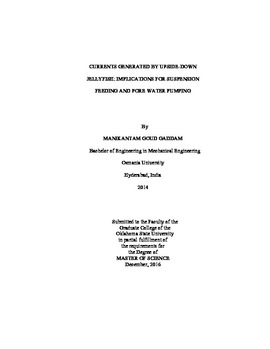| dc.contributor.advisor | Santhanakrishnan, Arvind | |
| dc.contributor.author | Gaddam, Manikantam Goud | |
| dc.date.accessioned | 2018-06-29T14:40:57Z | |
| dc.date.available | 2018-06-29T14:40:57Z | |
| dc.date.issued | 2016-12-01 | |
| dc.identifier.uri | https://hdl.handle.net/11244/300342 | |
| dc.description.abstract | The bottom or benthic boundary layer (BBL) of the oceans presents challenging conditions for foraging, on account of ambient flows as slow as few centimeters per second. Several marine invertebrates (such as sponges) have adapted to life in the BBL by generating steady currents for use in feeding on suspended particulate prey. Low-speed flows also limit nutrient cycling via pore water uptake. We examine how unsteady jets can impact suspension feeding and pore water entrainment using a model organism: the upside-down Cassiopea jellyfish. Cassiopea individuals are found attached to the substrate in shallow ocean waters such as mangrove swamps, with their bells and oral arms pointing upwards to the free surface. Through periodic contractions and relaxations of their bell margin, these sessile organisms generate vortex-dominated jets for feeding and nutrient exchange. We examined pulsing kinematics, flows, and transport characteristics in Cassiopea using videography, 2D particle image velocimetry (PIV) and planar laser induced fluorescence (PLIF). Multiple individuals with bell diameters ranging from 2 cm to 7 cm were investigated in laboratory settings under varying background flows. Pulsing frequency was observed to generally decrease with increasing bell diameter. Near-field PIV measurements showed that the ambient water was drawn toward the bell margin during each contraction to form a starting vortex. Continuous upward jets were formed after flow entrained by the bell was directed through the oral arms. Under background flow with mean velocity of 2 cm s-1, the penetration depth of the organism-induced jet decreased with increasing bell diameter. However, volumetric fluxes in the same background flow condition increased with increasing bell diameter. PLIF measurements showed suction pumping of fluorescent dye initially located 2 cm below the substrate. Coherent flow structures formed during bell contraction were broken into small-scale structures when the jet was advected upward through the oral arms. Smaller individuals with higher pulsing frequency showed closer placement of vortices from multiple pulsing cycles that aided in augmenting concentration flux. In contrast, larger medusae with lower pulsing frequency appear to potentially benefit from increased time-scale for suspension feeding and mixing of pore water, on account of their wider and slower jets. | |
| dc.format | application/pdf | |
| dc.language | en_US | |
| dc.rights | Copyright is held by the author who has granted the Oklahoma State University Library the non-exclusive right to share this material in its institutional repository. Contact Digital Library Services at lib-dls@okstate.edu or 405-744-9161 for the permission policy on the use, reproduction or distribution of this material. | |
| dc.title | Currents Generated by Upside-down Jellyfish: Implications for Suspension Feeding and Pore Water Pumping | |
| dc.contributor.committeeMember | Elbing, Brian | |
| dc.contributor.committeeMember | Sallam, Khaled | |
| osu.filename | Gaddam_okstate_0664M_14970.pdf | |
| osu.accesstype | Open Access | |
| dc.description.department | Mechanical & Aerospace Engineering | |
| dc.type.genre | Thesis | |
| dc.type.material | text | |
